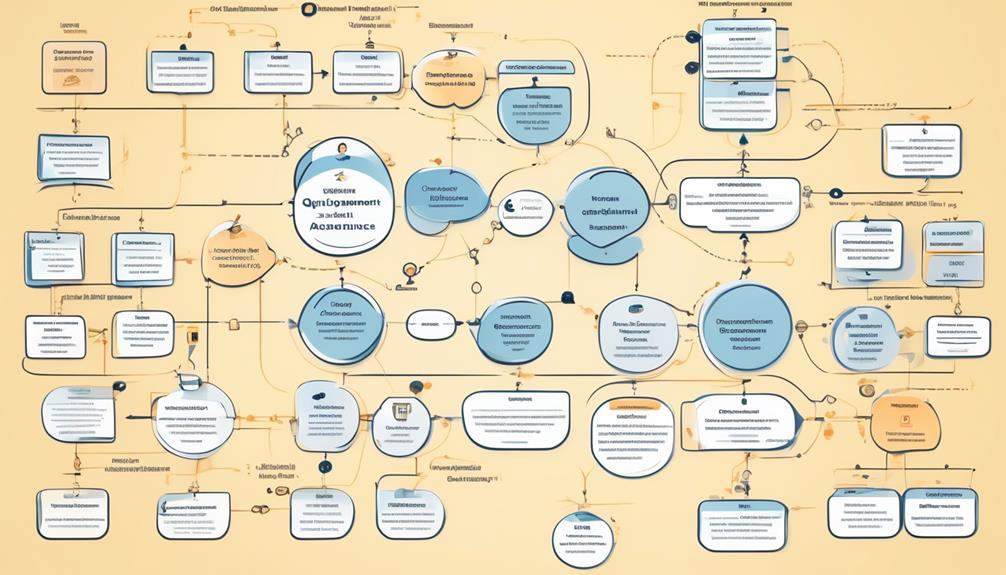Have you ever considered who is accountable for ensuring that the software we rely on meets our standards and is of high quality, despite the common understanding that software must be thoroughly evaluated and tested before being used?
A Software Quality Assurance Analyst plays a critical role in this process, but there's much more to their work than meets the eye.
The intricacies of their responsibilities and the impact they have on the software development lifecycle might surprise you.
Key Takeaways
- Software Quality Assurance Analysts are responsible for testing and ensuring software quality and functionality.
- They develop and implement testing plans, test cases, and test scripts to identify and document findings.
- SQA Analysts collaborate with developers, designers, and project managers to ensure products/services align with quality standards.
- The role of SQA Analysts is essential in the software development process, with high demand in the tech industry and competitive salaries.
Role of a Software Quality Assurance Analyst
As Software Quality Assurance Analysts, we're responsible for meticulously testing, analyzing, and ensuring the quality and functionality of software, products, and systems.
Our job entails developing and implementing testing plans, test cases, and test scripts to validate that the software meets pre-defined requirements and standards.
We play a pivotal role in the software development process by identifying and documenting findings, reporting defects, and tracking their resolutions.
Additionally, we confirm that the products or services align with company or industry quality standards, ensuring that end-users receive high-quality, reliable software.
As Quality Assurance Analysts, we conduct focus groups with customers to gather feedback and insights, which further contributes to the enhancement of the software's performance and user experience.
Our role is crucial in the development lifecycle, as we act as the gatekeepers of quality, striving to deliver software that meets the highest standards and exceeds customer expectations.
Responsibilities in Software Development

Collaborating with developers, designers, and project managers ensures that the software meets quality standards and customer requirements. As quality assurance (QA) analysts, our responsibilities in software development encompass various crucial tasks.
We play a pivotal role in developing and implementing testing plans, test cases, and test scripts to identify software defects and issues. Additionally, we meticulously document findings, report defects, and track resolutions to uphold the quality of software, products, and systems.
Moreover, conducting focus groups with customers is essential to identify needs and improve customer satisfaction through software quality assurance principles. Ensuring compliance with ISO standards for quality management is integral to our role, and we facilitate efficient and realistic planning for contingencies in the software development process.
Essential Skills for SQA Analysts
Our role as SQA analysts in software development demands a comprehensive understanding of the essential skills required to effectively assess and ensure the quality of software products and systems.
Proficiency in programming languages and attention to detail are vital for creating and maintaining test plans and documentation.
Understanding the software development life cycle and testing methodologies is crucial in ensuring that the quality of the software is maintained.
Strong analytical and problem-solving skills are necessary for identifying and reporting software defects effectively.
Additionally, effective written and oral communication skills are important for collaborating with cross-functional teams and reporting findings.
Time management is also a vital skill for meeting deadlines, delivering projects efficiently, and ensuring compliance with company standards.
These skills are essential for excelling in QA analyst jobs and are highly sought after in the tech industry.
Individuals looking to become a QA analyst or pursue tech jobs should focus on developing these skills that can help them succeed in becoming a Software Quality Analyst, especially those with a background in computer science.
Importance of SQA Analysts

SQA analysts play a pivotal role in ensuring the quality and reliability of software, products, and systems through rigorous testing and analysis. They're essential in confirming that products and services meet company or industry standards, contributing to customer satisfaction and the overall improvement of products and systems.
SQA analysts are responsible for developing and implementing testing plans, test cases, and test scripts to ensure quality. They also meticulously document findings, report defects, and track resolutions. Moreover, SQA analysts conduct focus groups with customers to gather feedback and enhance customer satisfaction.
In the tech industry, the demand for SQA analysts is high, and job opportunities are expected to grow in the coming years. Analysts typically work full-time, and a bachelor's degree in computer science or a related field is often required. The median annual salary for SQA analysts is competitive, reflecting the importance of their role in maintaining the quality and reliability of software, products, and systems.
As companies continue to prioritize quality assurance, the job outlook for SQA analysts remains promising, making it a sought-after career in the tech industry.
Career Opportunities in SQA
With high demand and potential for career growth, the field of Software Quality Assurance offers numerous opportunities for professionals looking to advance in the tech industry. QA analysts can find work in an office setting, collaborating with development teams throughout the software development process. Those with a master's degree in Science and Technology or related fields have increased prospects for career advancement and higher average salaries. The industry offers a range of career paths, from specializing in specific industries or technologies to advancing into management roles.
Competitive salaries, bonuses, and benefits make this an attractive career choice for those with the requisite education and training, typically a bachelor's degree in computer science or related fields, along with relevant certifications such as ISTQB or CSTE. Furthermore, there are ample opportunities for continuous learning and professional development to stay abreast of the latest trends and technologies in the field.
The responsibilities of a QA analyst include developing and executing test plans, identifying and reporting software defects, conducting quality assurance audits, and maintaining test documentation.
Frequently Asked Questions
What Does a QA Analyst Do in Software?
In software, a QA analyst ensures quality by testing, analyzing, and documenting. We develop and implement testing plans, cases, and scripts.
We report defects, track resolutions, and engage with customers to gather feedback. Collaborating with developers, designers, and project managers, we anticipate and prevent future problems.
Our role is crucial in maintaining high-quality software products and systems.
What Are the Qualifications to Be a Software Quality Assurance Analyst?
To become a software quality assurance analyst, one typically needs a bachelor's degree in computer science or a related field, along with relevant certifications like ISTQB or CSTE. Strong analytical and problem-solving skills, proficiency in programming languages, and attention to detail are crucial.
Practical experience through internships and projects is also valuable. A background in management can be advantageous.
This role offers opportunities for career growth and specialization in specific industries or technologies.
What Does a Software Quality Assurance Do?
Ensuring the quality of software is a multifaceted process that involves various tasks and responsibilities.
Firstly, we test, analyze, and develop testing plans. This includes identifying the different components and functionalities of the software that need to be tested and designing appropriate test cases and scripts.
Additionally, we document our findings during the testing process. This involves recording any defects or issues that we encounter and documenting them in a systematic manner. We also report these defects to the relevant stakeholders and track their resolution to ensure that they are addressed in a timely manner.
Furthermore, we ensure compliance with ISO standards. This involves following established guidelines and procedures to ensure that the software meets the required quality standards. Compliance with ISO standards is essential in ensuring that the software is reliable, secure, and efficient.
In order to gather feedback and continuously improve our products, we conduct focus groups with customers. This allows us to gain insights into their experiences and preferences, which we can then use to make informed decisions and enhancements to our software.
Is QA Analyst a Stressful Job?
Absolutely, being a QA analyst can be stressful at times. We constantly juggle deadlines, analyze intricate systems, and communicate effectively to ensure product quality.
Our attention to detail and problem-solving skills help manage stress, but the pressure is part of the job. It's crucial to maintain a healthy work-life balance and utilize time management techniques to navigate through the demands while delivering top-notch results.
Conclusion
In conclusion, a Software Quality Assurance Analyst is the detective of the software world, meticulously searching for any hidden defects or flaws.
They're the gatekeepers of quality, ensuring that only the best products reach the hands of the customers.
With their keen eye for detail and problem-solving skills, they play a vital role in the success of software development projects, ultimately safeguarding the reputation of the brand and the satisfaction of the customers.
Rick, our Software Quality Assurance Writer, is the creative force behind many of our insightful articles and course materials. His unique background in software development, fused with his natural flair for writing, allows him to convey complex QA concepts in a way that is both informative and captivating. Rick is committed to keeping abreast of the latest trends and advancements in software testing, ensuring that our content remains not just relevant, but at the forefront of the field. His significant contributions are instrumental in helping us fulfill our mission to deliver premier QA education.










